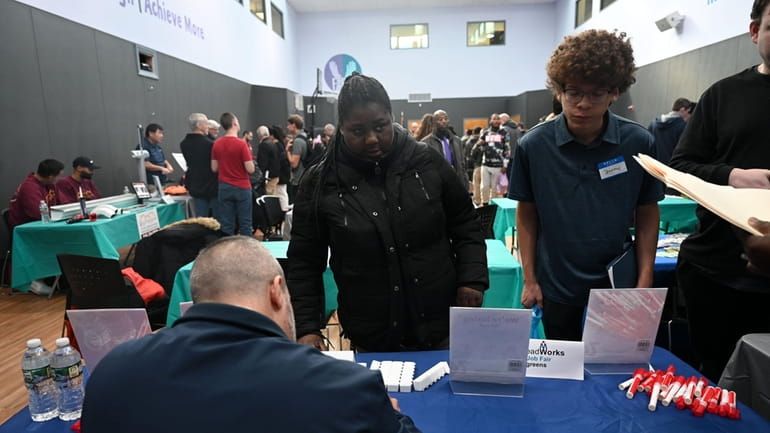Long Island hits record low unemployment rate of 2.2% in October

Vicky Bienvenu, 35, of Roosevelt, center, joined other job seekers and advocates while chatting with prospective employers at a job fair in Old Bethpage aimed at helping disabled job seekers, Wednesday, October 19, 2022. Credit: Danielle Silverman
Long Island's unemployment rate fell to 2.2% in October, the lowest it has been in the 32 years the state Department of Labor has tracked such data.
A monthly Labor Department report released Tuesday shows that the Island’s percentage of unemployed residents has fallen to its lowest level since 1990, when such record-keeping for the region began, providing evidence of an accelerated recovery from the pandemic and an overall increase in the Island’s tolerance to economic downturns, economists said.
The number of employed Islanders hit a record high of 1.51 million last month, while the number of unemployed residents looking for work fell to a record low of 33,800, said Shital Patel, labor market analyst for the Labor Department’s Hicksville office.
The labor force, too — the sum of all employed residents and those looking for work — has hit a high-water mark for the month of October compared to the same month in previous years, reaching 1.54 million.
Despite the overall good news, Patel said it’s hard to pinpoint the exact reasons behind the growth in the labor force.
“We see a continued expansion of the regional labor force since the pandemic,” Patel said. “It’s hard to say why that is happening. It’s weird because the population isn’t growing.”
Patel said the Island’s total population has remained relatively flat for years, adding that the increase in the labor force recently could be attributable to a tight job market more favorable to workers, the return of some retirees to the workforce, and most notably, the possible migration of New York City residents to the suburbs.
Long Island’s private sector regained a large portion of jobs lost to the pandemic, but the region's total remains 33,900, or 2.9%, below pre-pandemic levels, according to a state jobs report released last week. Despite the gap, the Island’s number of employed has never been higher.
Migration of city residents to Nassau and Suffolk “may be why the number of jobs in our jobs report hasn’t recovered yet, considering we have so many more employed residents,” she said.
“Long Island may have been a net beneficiary of New York City transplants looking for more space and a yard for their growing families,” Patel said. “The pandemic also increased remote work opportunities and flexibility, which may have allowed more people with child care and other family caregiving responsibilities opportunities to re-enter the workforce.”
John Rizzo, economist and Stony Brook University professor, said the Island has several underlying economic strengths that have made it not only more resilient to the pandemic’s effects, but more/able to withstand economic downturns.
“A more educated workforce and more diversity in the economy has made Long Island more resilient,” Rizzo said. “Years ago, the Island used to rely more on manufacturing.”
Combined with other improvements, like in telecommunications and infrastructure, the Island is in a better place to face economic fluctuations.
Separately from the monthly unemployment figures, a report released by state Comptroller Thomas P. DiNapoli's Office showed that only three regional labor markets — Long Island, New York City and the Hudson Valley — out of 10 in the state saw their labor forces grow over the last decade.
New York State’s labor force, despite it being one of the largest in the country, declined by 1% between 2011 and 2021 while the United States overall saw its labor force grow by 5.1%.
While the state overall saw a rebound in its otherwise declining labor force in the second half of the last decade, COVID-19 undid much of that progress. The state is still 400,000 workers below December 2019 levels.
“My report shows troubling long-term trends were exacerbated by the pandemic and may be impeding New York’s recovery,” DiNapoli said in a statement. “Challenges may lie ahead that could negatively affect economic growth and state and local tax collections.”
“Policymakers must give attention to policies that foster labor participation and encourage workforce development,” he said.
Rizzo said the comptroller’s report highlights a great disparity between the downstate region and the more rural upstate region.
“It really is a tale of two New Yorks,” Rizzo said. “There’s the New York metro area, which includes Long Island, and then there's everyone else. They’ve had very different experiences in terms of labor force and employment.”
He credits the region’s diverse economy and proximity to New York City for its increased labor force.
“Going into the pandemic, the Island had several advantages going for it,” he said.
Peaks and valleys
Past highs and lows in Long Island's unemployment rate correspond with economic cycles and the pandemic shutdowns:
8.4% — July 1992, amid a national recession.
2.8% — December 1999, during '90s boom.
8.5% — February 2010, during the 2009-12 Great Recession.
4% — February 2020, just before the coronavirus pandemic.
18.2% — April 2020, as pandemic shutdowns peaked.
2.2% — October 2022, with pandemic shutdowns behind us.
